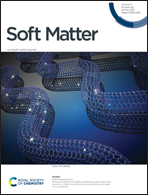Detection of polymer compatibility by means of self-organization: poly(ethylene oxide) and poly(sodium 4-styrenesulfonate)
Abstract
Information on the miscibility of different polymers A and B on a molecular level is important in many ways. However, along the traditional lines this knowledge is difficult and time consuming to achieve. The current study presents a simple alternative, based on the determination of the intrinsic viscosities (specific hydrodynamic volume of isolated coils) for blend solutions in a common solvent. In the case of incompatible polymers, isolated coils contain one macromolecule only, either A or B. In contrast, compatible polymers form mixed isolated coils, because of favorable interactions. The present investigation was carried out for the system water/poly(ethylene oxide)/poly(sodium 4-polystyrenesulfonate), for which the reason of compatibility lies in the formation Na+ bridges between the sulfonate groups of the polyelectrolyte and the OH groups of the poly(ethylene oxide). Zero shear viscosities were measured as a function of polymer concentration for blends of different compositions and modeled quantitatively by means of relations yielding the excess intrinsic viscosities ε (zero in the case of incompatibility) and viscometric interaction parameters. Particular attention is being paid to the role the molar masses of the polymers play for the resulting ε values.



 Please wait while we load your content...
Please wait while we load your content...